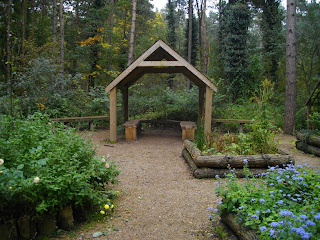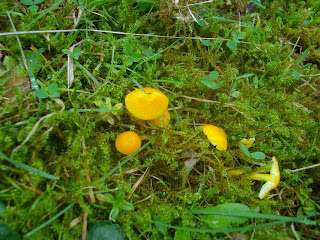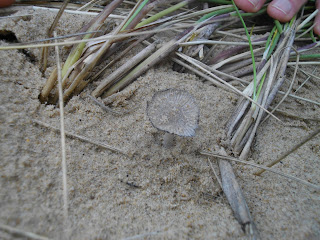10th October 2015
On Saturday I met Adam in North Walsham and we headed to Felmingham to visit Bryant's Heath. When I was growing up my dad and I would visit the heath every spring to look for Adders, Common Lizards, Green Hairstreak and Green Tiger Beetles, but it had been over ten years since I last visited. The track down to the heath had some large water-filled divots in it, so I parked on the verge and we walked the rest of the way.
Felmingham Heath has a SSSI designation because of the mixture of habitats (areas of wet and dry heathland, plus areas of wet and dry woodland too). Given the time of year we decided to focus mostly on fungi, so we entered the woodland around the north-western edge of the heath. It was immediately obvious that there was a lot of fungi about, with large amounts of Ochre Brittlegill, Butter Cap and Amethyst Deceiver growing along the sides of the path. We were to see hundreds of the first two species, perhaps even thousands. We also bumped into Gordon Woolcock, a local naturalist that who posts on the Norfolk Wildlife Facebook page. We had a chat about some of the species he has seen on his regular walks here, and it was nice to put a face to a name.
Ochre Brittlegill (formerly Common Yellow Russula before the crazy re-namers got it)
The first non-fungal thing of interest we saw was a dead Dor Beetle. It was lying on its back, and the underside was a metallic bluey-purple (this feature separates it from female Minotaur Beetles). Further along we saw some absolutely huge Earthballs, several species of Milkcap and Russula, and our first Boletes of the day. I spotted some tiny stalked cup fungi growing from an acorn, which delight in the name 'Nut Disco'. Whilst it sounds a rather silly name, the boring explanation is that the 'disco' part is short for discomycete, an old taxonomic grouping of small, disc like fungi.
The underside of a Dor Beetle. This is probably Common Dor Beetle, but there is a similar one called Common Dumble Dor. No, there actually is.
Larger than normal Common Earthball, which has burst open.
Nut Disco growing on an acorn
Heading out onto the heathland we saw the first of many Fly Agarics. Many were the deep red you would normally associate with this species, whilst others were more orangey as a result of age and weathering. A recent online discussion had highlighted that there is actually an orangey form of Fly Agaric called var aureola, and at least one young-looking specimen may have been of this form. Another interesting fungus was Earthfan, which was growing along the edge of a heathland path.
Earthfan
Fly Agarics (possible var aureola on the left)
Having seen some rather large holes in the ground (too big to be made by Field Digger Wasps, which also dig here) we finally tracked down the culprit, a Minotaur Beetle. It reared up and pointed its 'horns' at us, so we took a few photos and allowed it to go about its business, which mostly involves rolling dung into balls and hiding it in holes. Still, each to their own. On the way back to the car we stopped to watch a flock of birds flying past, which included several Goldcrests mixed in with Long-tailed Tits. A Treecreeper and at least two calling Bullfinches were also nice to see.
Male Minotaur Beetle
Before dropping Adam home we stopped at one of North Walsham's car parks to look for Ivy Bees, a species that has only begun to colonise Norfolk in the past few years. We found a clump of Ivy in flower, but it was rather overcast and it didn't come as any great surprise that we didn't see any bees.




















































